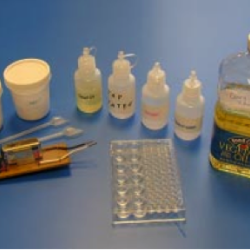Source Institutions
Source Institutions
Add to list Go to activity
Activity link broken? See if it's at the internet archive

Learners are challenged to create solutions that conduct electricity and make a buzzer buzz (or an LED light up). They are given water, salad oil, alcohol, and vinegar as liquids, salt and sugar as solids, and a conductivity tester to see which combinations conduct electricity. Some liquids conduct by themselves (vinegar), and others can be made to conduct when salt, but not sugar, is added. The chemical explanation is that positive and negative particles called "ions" make solutions conductive. Depending on the age of learners, this activity may require constant supervision of all materials and steps. Instructions are provided for building simple conductivity testers, or these can be purchased.
- 10 to 30 minutes
- 10 to 30 minutes
- Over $20 per group of students
- Ages 4 - 14
- Activity, Experiment/Lab Activity
- English
Quick Guide
Materials List (per group of students)
- 25 60-mL plastic dropping bottles
- 5 24-well plates
- 25 3-oz. plastic cups labeled for solutions and liquids
- toothpicks as stirrers
- plastic wash bottle with distilled water
- small plastic spoons to transfer salt and sugar
- several liters of distilled water for rinsing well plates
- 100 grams of sugar
- 100 grams of salt
- 100 mL salad oil
- 100 mL vinegar
- large bolt or nail for demonstrating the buzzer
- paper towels for spills
- container of clean water
- safe container to dump solutions into and seal (waste container)
- 5 conductivity testers/buzzer type (purchased or from instructions in PDF)
- 9-V batteries (self-made tester)
- battery snap connectors (self-made tester)
- 2 12" lengths of wire (black and red) (elf-made tester)
- 1 light-emitting diode or siren (buzzer) (self-made tester)
- 1 kilo-ohm 1/4 watt resistor (self-made tester)
- 12 inches of black electrical tape (self-made tester)
- 1" X 6" thin wood (tongue depressor works) (self-made tester)
- tape solder (self-made tester)
- LED or buzzer (self-made tester)
- scissors (self-made tester)
- wire stripper (self-made tester)
- pliers (self-made tester)
- matches, candle or soldering iron (for self-made tester)
- safety goggles
Subjects
-
Physical Sciences
-
Electricity and Magnetism
- Electric Charges and Currents
- Electric Circuits
-
Chemistry
- Acids and Bases
- Solutions
-
Electricity and Magnetism
Informal Categories
- Electronics
Audience
To use this activity, learners need to:
- see
- touch
Learning styles supported:
- Uses STEM to solve real-world problems
- Involves hands-on or lab activities
Other
Components that are part of this resource:
This resource is part of:
Access Rights:
- Free access
By:
Rights:
- All rights reserved, Sciencenter,
Funding Sources:
- Camille and Henry Dreyfus Foundation, Inc.
- American Chemical Society
